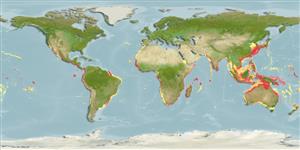分类 / Names
俗名 | 同种异名 | Catalog of Fishes(属, 种) | ITIS | CoL | WoRMS | Cloffa
Issue
This species is considered as a junior synonym of Mobula mobular according to Last et al., 2016 (Ref. 114953) and White et al., 2017 (Ref. 115945:13). The species page will be removed,.
Environment: milieu / climate zone / depth range / distribution range
生态学
海洋 礁区鱼类; 深度上下限 0 - 647 m (Ref. 106604), usually 0 - 200 m (Ref. 89423). 亞熱帶的; 40°N - 30°S
Indo-Pacific: off South Africa, the Arabian Sea eastward to the Hawaiian Islands and Polynesia. Eastern Pacific: on the continental coast. Eastern Atlantic: Côte d'Ivoire but may probably be more wide-ranging. This has to be critically compared with Mobula mobular of the Mediterranean Sea and nominally elsewhere in the North Atlantic.
印度-太平洋: 南非外海, 阿拉伯海向東至夏威夷群島與玻利尼西亞。 東太平洋: 在大陸沿岸上。 西大西洋: 象牙海岸但是可能可能更廣泛分佈。 這必須嚴格地被與地中海的 Mobula mobular 相較與有名無實地在北大西洋中的別地方。
Length at first maturity / 大小 / 重量 / 年龄
Maturity: Lm 217.8, range 204 - ? cm
Max length : 310 cm WD 雄鱼/尚未辨别雌雄; (Ref. 50641); 240.0 cm WD (female); common length : 225 cm WD 雄鱼/尚未辨别雌雄; (Ref. 9256)
Dark blue to black above, white below. Inner surface of cephalic fins silver grey with black tip, outer surface and side behind eye white (Ref. 11228). Shared characters between M. rancureli and Mobula japanica: teeth, placoid scales, and branchial filter morphologies, morphometrics, presence of tail spine, distinctive shape and coloration of dorsal fin, and general shape of body and coloration (Ref. 50641).
背面深蓝色到黑色的, 腹面白色的。 头部鳍的内面银色的灰色有黑色的顶端,外部的表面与眼睛后侧白色.(参考文献 11228) 分享了在 M. rancureli 与 Mobula japanica 之间的特徵: 齿,盾鳞与鳃的过滤器形态学 , morphometrics, 有背鳍的尾部棘,特殊的形状与颜色 , 与身体与颜色的一般形状。 (参考文献 50641)
Found inshore, possibly in oceanic waters (Ref. 9911). Pelagic (Ref. 58302). Occurs singly or in groups (Ref. 9911). Feeds mainly on euphausiids (mainly Nictiphanes simplex), and to a lesser extent on copepods and crustacean larvae. May also feed on small fishes. Ovoviviparous (Ref. 50449). Acoustic tracks record the species to spend time above the thermocline at night to feed on krill (H. Dewar, pers.comm. 05/2000). Very common by-catch of the gillnet fisheries targeting skpjack tuna (Katsuwonus pelamis). Utilized for its gill filter plates (very high value), meat, cartilage and skin (Ref.58048).
发现于岸边了, 可能地在大洋性水域中.(参考文献 9911) 各别地生存或成群.(参考文献 9911) 主要吃磷虾 (主要地 Nictiphanes 单工 ), 与少部分的桡脚类的动物与甲壳类幼生。 可能也吃小鱼。 卵胎生的.(参考文献 50449)
Life cycle and mating behavior
成熟度 | 繁殖 | 产卵场 | 卵 | 孕卵数 | 仔鱼
Exhibit ovoviparity (aplacental viviparity), with embryos feeding initially on yolk, then receiving additional nourishment from the mother by indirect absorption of uterine fluid enriched with mucus, fat or protein through specialised structures (Ref. 50449). With one in a litter (Ref. 12951). Size at birth 85-92 cm WD (Ref. 12951, Ref.58048).印度-太平洋: 南非外海, 阿拉伯海向東至夏威夷群島與玻利尼西亞。 東太平洋: 在大陸沿岸上。 西大西洋: 象牙海岸但是可能可能更廣泛分佈。 這必須嚴格地被與地中海的 Mobula mobular 相較與有名無實地在北大西洋中的別地方。
Last, P.R. and J.D. Stevens, 1994. Sharks and rays of Australia. CSIRO, Australia. 513 p. (Ref. 6871)
世界自然保护联盟红皮书 (Ref. 130435: Version 2024-1)
人类利用
渔业: 商业性
工具
特别资料
下载 XML
网络资源
Estimates based on models
Preferred temperature (Ref.
123201): 17.5 - 29, mean 27.4 °C (based on 5840 cells).
Phylogenetic diversity index (Ref.
82804): PD
50 = 0.5005 [Uniqueness, from 0.5 = low to 2.0 = high].
Bayesian length-weight: a=0.01000 (0.00244 - 0.04107), b=3.04 (2.81 - 3.27), in cm total length, based on all LWR estimates for this body shape (Ref.
93245).
营养阶层 (Ref.
69278): 3.4 ±0.43 se; based on food items.
Generation time: 9.2 ( na - na) years. Estimated as median ln(3)/K based on 2
growth studies.
回复力 (Ref.
120179): 非常低的, 最小族群倍增时间超过14 年 (Fec=1).
Fishing Vulnerability (Ref.
59153): High vulnerability (58 of 100).
Nutrients (Ref.
124155): Calcium = 2.5 [0.3, 39.7] mg/100g; Iron = 0.39 [0.03, 4.65] mg/100g; Protein = 21.4 [16.2, 26.7] %; Omega3 = 0.111 [0.035, 0.336] g/100g; Selenium = 28.3 [5.3, 165.3] μg/100g; VitaminA = 9.7 [0.8, 119.6] μg/100g; Zinc = 0.322 [0.021, 3.683] mg/100g (wet weight);
